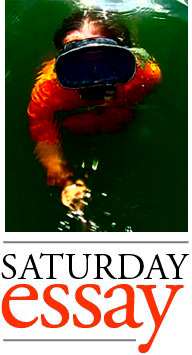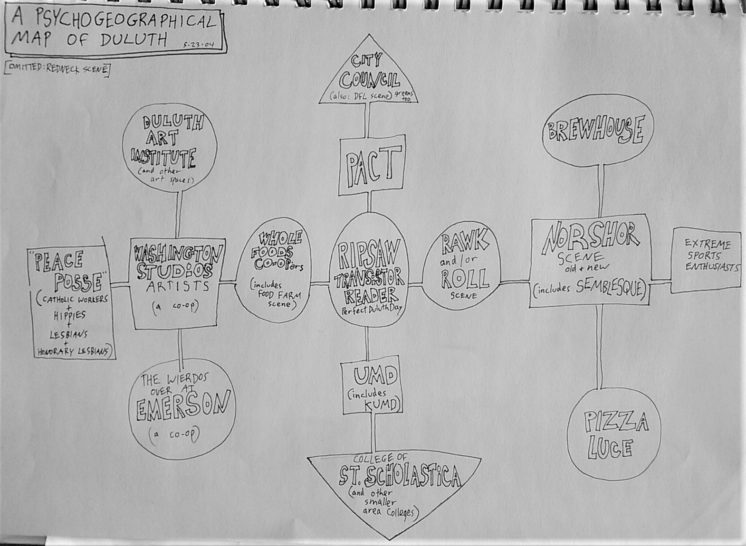A Psychogeographical Map of Duluth, 2004
 I drew this conceptual map of Duluth’s arts-and-music-scene in 2004, then filed it away for 18 years. The details may only interest old-school scenester hipsters, but the broad strokes reflect my thinking on what makes Duluth cool, and the nature of scenes as social units. The word “psychogeographical” refers here to the artistic arrangement of my little sociological analysis.
I drew this conceptual map of Duluth’s arts-and-music-scene in 2004, then filed it away for 18 years. The details may only interest old-school scenester hipsters, but the broad strokes reflect my thinking on what makes Duluth cool, and the nature of scenes as social units. The word “psychogeographical” refers here to the artistic arrangement of my little sociological analysis.
Local rocker Nat Harvie once observed to me that old-school Duluthians gush about these bygone days with little provocation. True. I moved to Duluth in 1998 in what is widely regarded as its heyday, its coming-to-awareness-of-itself as a music-and-arts scene. This can be roughly correlated with the formation of the Ripsaw News, now long defunct. That storied rag began in opposition to the Reader as the premier alternative newsweekly and we were off to the races. I remember an early Ripsaw meeting with Brad Nelson and Cord Dada and a room of creatives, and the question was, “Who can do what?” I said, “I am a writer and cartoonist,” and I was in.
Duluth had everything I wanted in its vital percolations. I graphed the scene as I saw it, below:
The Central Node
The central node contains the alternative local print media of the time — the Reader, the Ripsaw, the Transistor, and the up-and-coming community blog Perfect Duluth Day. I considered this map for publication in any of those titles, as I’d been a part of each, but I must have gotten distracted. The Ripsaw was dying and its discontents were forming the Transistor (now defunct); meanwhile the Reader was trying to poach me, and they all wished they were PDD.
It was sort of “entertainment calendar wars.” The content of these publications supports their calendar. Part of the dissolution of the Ripsaw is that bitter ex-staff started the Transistor, which although a mere street-sheet, it had a better calendar. I heard the Ripsaw, on its last legs, tried buying them out, got rebuffed, and that was it. To compete with this churning gaggle, the Duluth News-Tribune created a pull-out entertainment section called the Wave, with the dimensions of an alternative newsweekly, featuring an entertainment calendar.
Everyone looked to these publications to find out what was happening, so the scene seemed to orient around them; that’s why they’re in the center. I should have also mentioned the zine scene, the true alternative print media. By its underground nature it is sporadic, but always cool. For instance the Prøve Gallery devotes space to a zine library and that is appropriate and necessary and good.
The Vertical Axis
Branching off the central node along the vertical axis, I included media besides print. The upper portion of the vertical axis is the city government arm. It funds Public Access TV or PACT, which I was a part of as I began dabbling with video. For about a year, I was writing a weekly column for the Ripsaw, drawing a weekly Ripsaw cartoon, and making a weekly PACT TV show. I finally dropped the show; it wasn’t very good (a lot of raw footage with sketchy audio), but PACT’s people-powered conduit electrified me. (Local Public Television is also in the game.) My best use of the airtime was to make a handful of music videos for local musicians, which I still do occasionally.
Indicating where its funding came from, the PACT node leads up to the city council node. My notes indicate “also: DFL scene” and “greens too.” These were the portions of Duluth’s Venn Diagram of progressive politics that I interacted with. The Ripsaw had formed largely to fight Mayor Gary Doty, who was considered the last of the old-school dinosaurs. This tracks with the genesis of Mayor Don Ness in his boy-genius-city-councilor phase. In the process, Russ Stewart rose to prominence as a Green on the city council, before what I consider to be his glibertarian fall from grace. But you could feel things buzzing in the halls of power, and then you’d see the local politicians at a show because we all dig that crazy scene. We went from fighting city hall to the mayor launching Homegrown every year.
That was the great thing about the Ripsaw — it positioned itself as the voice of the creative class, emphasizing the connection between the streets and city hall. Other publications were jolted awake, and began catering to the interests of the music and arts scene that the Ripsaw grew from.
The lower arm of the vertical axis is comprised of the city’s university and college populations. This includes the University of Minnesota Duluth’s media presence in the form of KUMD (now North 103.3). College radio is indispensable. Duluth’s college-town status insures an influx of new ideas, new talent, and new readers of entertainment calendars. Campus publications, although insular, play a role. The kids are alright.
The Horizontal Axis – Left Side
The left side of the horizontal axis is where the music-and-art scene intersects with people-powered social structures.
It may seem odd to include Whole Foods Co-op in “the scene,” but having worked there for a quarter century, I can attest to it. For one thing it’s literally a community co-op, just like it claims to be — a genuine social hub and green business owned by your friends and neighbors. So many artists and musicians have worked there over the years, just listing some former employees would sound like gratuitous name-dropping. The co-op donates food to art openings, keeps wall space available for local art, and incorporated local art into store design. Low immortalized the Hillside location by filming a music video there.
Noted in the Whole Foods Co-op node is one of its moving parts: “Includes Food Farm scene.” This is a nod to small local farming in general, and other efforts to localize and green up the region’s food system. Those efforts are uncompromisingly hip. The Food Farm — namely, the Fischer-Merritt family and associated organic farms in Wrenshall — is the most prominent. The annual Free Range Film Festival (“Movies in a Barn”) out there quickly became an arts destination, inspiring people to pick up cameras, enter films, and engage with their community.
Continuing leftward on the horizontal brings us to the art-forward, people-powered nests of activity which I centered on the “Washington Studios artists.” A co-op at the time, Washington was a real hotbed and it still is. Some of the best nights of my life, and some of my greatest achievements, have been art events at Washington Studios. Something about a bunch of artists living with a gallery brings focus to the mission.
Below that node is “the weirdos over at Emerson, a co-op.” Emerson is the punk rock version of Washington Studios. It isn’t specifically for artists like Washington Studios is or was. But in practice, Emerson concentrates artists in an even more communal environment. My mind has been blown many times at Emerson: bands, parties, art shows, Olympic-level paddleball in their gymnasium. Emerson is like pagan Rome.
Above the Washington Studios node is “Duluth Art Institute and other art spaces.” I prioritized the Duluth Art Institute because of its member shows and other events; every local artist wants to show there. It is not a co-op but it is a democracy.
One must also include the Tweed Museum for its student shows and its support for our regional geniuses. Local artists are represented in the Tweed’s permanent collection and that makes me jealous. Maybe I’ll sneak something onto their walls.
As well as these institutions, I consider the town’s other galleries, and any venue that hangs local work. Art openings in coffee shops can be as vital as art openings in museums, often more so.
The last node on the left of the horizontal axis is the “Peace Posse,” which includes the Catholic Workers, namely the old-school hippies (and other activist communities of faith) whose idea of a good time is getting arrested protesting nukes. Religious or otherwise, Duluth has a lot of progressive activists, protestors, organizers, allies and supporters, doing the Lord’s work. They are a scene of their own, with strong connections to the arts community, the food community, and local politics. Partying with these people often involves singing folk standards around a firepit, with acoustic instruments including banjos and fiddles. I also think of larger productions in venues like Peace Church and the Coppertop Church, involving choirs, giant puppets, and poetry.
I mention “Lesbians” which I wish I hadn’t because it sounds ignorant; I was referring to a specific network of back-to-the-land organic peace lesbians who I was tangentially affiliated with for a minute. And they were making things happen and they still are. “Honorary Lesbians” cheekily refers to my girlfriend at the time and myself, who pitched in. Duluth’s original giant papier-mâché protest puppets had their origins from this nexus.
Horizontal Axis, Right Side
The right side of the horizontal axis is music oriented.
The first node from the center is the “Rawk and/or Roll” scene, the phrasing the Ripsaw always used. I attribute the phrase to fellow Ripsaw columnist Mark Lindquist, a protean figure in Duluth music.
Every now and then I overhear a Duluth-music-scene-hater. One hears variants of “It used to be so much cooler.” That’s bullshit. Yes, it used to be the coolest scene ever — without a doubt! But speaking for myself, I never saw it let up. My live music needs have always been met. The weird COVID-era notwithstanding, Duluth has the chops and a never-ending stream of hungry musicians dying to lay it down. Some cities don’t have that. Go to fucking Rochester if you don’t believe me. Duluth has the goods. To me it still feels like a party at the edge of the world.
To the right of the “Rawk and/or Roll” node is a cluster of the three main venues I frequented. This is not comprehensive, but from them I could draw connections to every other venue I explored, and venues yet to open.
The first node is the “Norshor Theatre scene.” “Old & new” it says, so the years Rick Boo managed it must have been over. Whatever was “new” didn’t stay cool very long. The legendary Boo days were so rock ‘n’ roll — with three stages and that world-rending mezzanine bar — sigh. See, this is what Nat Harvie was complaining about.
“Semblesque” is the local dance troupe founded by Jill Hall, which performed a run of shows at the Norshor based on my “Gonzo Science” album, and we even did some nights on the road. The experience was a great window into regional dance and theater. There is not enough dance and theater on this chart and I apologize for that. Let Semblesque stand for it all. Dance troupes continue multiplying here with the Spin Collective, the burgeoning burlesque scene, etc. The theater scene grew too, including the restoration of the Norshor, which was a dump. A cool dump, but a dump. Now it’s nice, but those mezzanine bar days are over for good. I would kill to see a cool bar in there again.
Below the Norshor node is the node for Pizza Lucé. Lucé is the literal center of town with its giant neon “liquor” sign. That sign is the city’s spinning axis. Lucé has always been a prime music and art venue. Imagining modern Duluth without the contributions of Pizza Lucé is very, very difficult.
Above the Norshor node is the Brewhouse node. In those days the Brewhouse was a go-to for live music. Even with that tiny stage, the right people got on it; Charlie Parr’s long residency stands out. Brewhouse alumni went on to form Hoops Brewing and Earth Rider Brewing.
Other venues too numerous to mention should be on here. Also house parties, outdoor concerts, and street festivals. The poetry scene deserves more love too, with its readings and publications and its own event at Homegrown.
The final node all the way to the right is “Extreme Sports Enthusiasts.” I didn’t know where else to put them. They’re pretty rock ‘n’ roll so they belong here. An icon of this Duluth type is Jason Cork, former Whole Foods Co-op employee, rawk aficionado, and ski-bum who moved to Colorado chasing snow and now coaches Olympians.
I also think of the Banff film festivals I’ve stumbled across here, and everyone who is nutty for Duluth’s outdoors in any season. The skiers, the snowshoe explorers, the ice climbers, the skaters in 20 below, the hard trail riders, the long-distance runners, the kayakers, windsurfers, scuba divers, and the surfers with ice beards. Duluth’s extreme sports enthusiasts are hardcore, they love to rock, and they are thirsty. They remain a crucial and growing component.
Below the title, I wrote in parentheses, “Omitted: Redneck scene.” I would have added them, but it affected the symmetry of the chart. Duluth has its share of rednecks, and I wanted to acknowledge them. They are unavoidable. Some of my best friends are rednecks.
A natural response to this essay will be to list everything you feel I shortchanged, slighted, or forgot to mention. This map was only meant as a shorthand overview, from one person’s perspective in 2004.
And if you think the scene is dead: Long live the scene.
An index of Jim Richardson’s essays may be found here.
Recommended Links:
Leave a Comment
Only registered members can post a comment , Login / Register Here













14 Comments
Marisa Lee
about 2 years agoChester Knob
about 2 years agoJim Richardson (aka Lake Superior Aquaman)
about 2 years agoSonya
about 2 years agoJim Richardson (aka Lake Superior Aquaman)
about 2 years agocork1
about 2 years agoChester Knob
about 2 years agoJim Richardson (aka Lake Superior Aquaman)
about 2 years agoGhist1
about 2 years agoJim Richardson (aka Lake Superior Aquaman)
about 2 years agoRebecca StGeorge
about 2 years agoJim Richardson (aka Lake Superior Aquaman)
about 2 years agoEmma Redgreen
about 2 years agoJim Richardson (aka Lake Superior Aquaman)
about 2 years ago